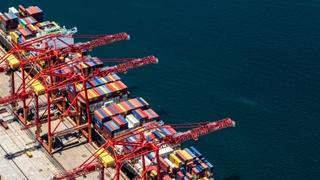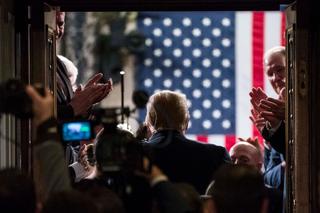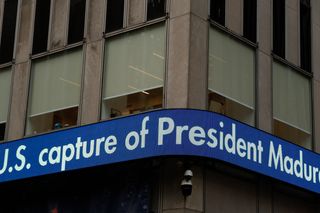Foreword
On 19 and 20 June 2024, the United States Studies Centre (USSC) hosted a major international conference in Sydney spotlighting the search for “economic security in a turbulent world”. Over a day and a half, the conference brought together leading policymakers, business executives and independent experts from around the world to discuss arguably the defining economic policy debate of our age – how to reconcile security and prosperity in an era of strategic competition and economic interdependence.
That the post-Cold War era of efficiency-first globalisation is over formed the inescapable conference backdrop. Global economic relations and policies are being recast for a more fractured and contested world with the tension between security and prosperity greater now than it has been for generations.
Global economic relations and policies are being recast for a more fractured and contested world with the tension between security and prosperity greater now than it has been for generations.
Topics addressed by conference speakers included: what is “economic security” and how has this concept emerged at the centre of policy debates; what sorts of tools are being developed to protect and enhance economic security and what are the trade-offs policymakers face; how does the rules-based trading system remain relevant in this new era; what matters most to business given greater geopolitical risk and economic volatility; how is rapid technological change defining the economic security agenda; and how is a country like Australia positioned to support both energy security and the green energy transition.
This report provides a summary of conference proceedings. The conference was well-attended and received widespread media coverage. The USSC appreciates the support received for the conference from the Australian Government, from our conference major partners – the Minerals Council of Australia, Microsoft and the Asia Natural Gas & Energy Association – and from our media partner, the Financial Times.
Conference program
View the full conference program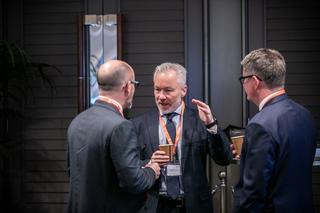
Welcome and opening remarks
Dr Michael Green, Chief Executive Officer of the United States Studies Centre, opened proceedings by noting the “inescapable reality that geopolitical tensions and a more contested international order are reshaping the contours of the global economy.” This is not cyclical. It will be a feature of the international environment for the foreseeable future.
Geopolitical risk is igniting the search for economic security in a turbulent world – the theme of the conference. Economic orthodoxies are under challenge and policies geared to a world of deep globalisation are being transformed as countries seek to rebuild industrial capacity in key sectors, secure advanced technologies and ‘de-risk’ economic vulnerabilities. This conference is an opportunity to hear from leading policymakers, business executives and independent experts on government and corporate strategies for navigating greater geopolitical risk and economic uncertainty.
In video remarks, the US Commerce Secretary, Gina Raimondo, observed that “in a world where national security is more reliant on advanced technology, economic security matters more than ever.”
“In a world where national security is more reliant on advanced technology, economic security matters more than ever.”Gina Raimondo
Economic security is also central to “the strong and enduring relationship between the US and Australia” and to wider cooperation under the Indo-Pacific Economic Framework (IPEF). In a short space of time, IPEF has delivered three important agreements – on strengthening supply chains, supporting clean economy transitions and enhancing transparent and predictable business environments.
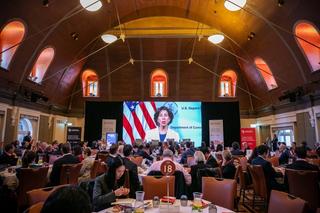
The United States and Australia share concerns about economic coercion, trade distorting subsidies and unfair trade practices. Joint work on critical minerals supply chains is bearing fruit and the bilateral relationship provides a model of how two like-minded countries can cooperate on economic security challenges.
Session 1 | Geopolitical turmoil and the search for economic security
In his keynote address, Alan Beattie, Senior Trade Writer at the Financial Times, identified US-China tensions, changes in technology and the threat of climate change as among the main drivers of the search for economic security. It is a hard concept to pin down, but a neutral definition would emphasise “governments intervening in a variety of ways to manage the trade-off between trade and growth on the one hand and security on the other, usually responding to geopolitical risk or natural phenomena (e.g. climate change and pandemics) which can often take on geopolitical aspects.”
As geopolitical tensions have risen, security-related interventions have expanded. From a narrow focus on dual-use technologies, there is now a wider spectrum of strategic technologies (e.g. semiconductors) and forms of state conflict (e.g. cyber security). The economic security lens has expanded further as the range of commercial chokepoints (e.g. undersea cables and gas pipelines) and production inputs of critical materials such as rare earths have become geopoliticised. High-value, high-technology products like electric vehicles don’t have direct national security implications but are viewed as important economically and strategically. At the outer limit, economic security can become “whatever governments define it to mean.”
At the outer limit, economic security can become “whatever governments define it to mean.”Alan Beattie
Economic security strategies are shaped necessarily by a country or region’s economy, geography, domestic institutions and politics. Australia, the United States, the European Union (EU) and Japan offer contrasting examples. Australia’s ability to withstand Chinese economic coercion attracted significant attention internationally. Though superficially vulnerable as an open economy highly dependent on Chinese demand, an adaptable export sector and degree of bipartisanship on China policy allowed Australia to “roll with the punch.”
Notwithstanding fragmentation pressures, other forces are working to prevent a split into economic blocs. In the context of US-China rivalry, a lot of countries want a “foot in both camps.” This provides some confidence that the drive for economic security is not going to pull the world economy apart.
Providing a US policy perspective, Emily Kilcrease, Senior Fellow at the Center for New American Security, drew a distinction in the panel discussion between “non-optional” US measures (e.g. export controls on semiconductors) and other cases of domestic politics impacting decisions (e.g. opposition to Nippon Steel’s purchase of US Steel). A high degree of executive branch discretion in this area means “breaking open the economic security toolkit” carries risks of “scope creep.”
Evaluating whether economic security tools actually work and better aligning policies across like-minded governments are key tasks. In the US interagency processes, traditional checks on restrictive measures have diminished, with the Department of Commerce and the Office of the US Trade Representative playing different roles than in the past. All agencies are more focused on security, the voice of industry is less influential in some areas and public opinion can appear more detached from economic consequences. Notably, research has found that support for the Republican Party increased in communities most negatively impacted by Trump-era tariffs.
In terms of corporate strategy, Ziad Haider, Global Director of Geopolitical Risk at McKinsey & Company, noted the paradox whereby many companies have grown up with connectivity, yet that connectivity is now paired with a highly contested global order. Beyond obvious areas of geopolitical risk like US-China tensions, war in Ukraine and conflict in the Middle East, another focal point is the number of democratic elections this year.
Geopolitical risk can boil down to where factories are located. Is it in a “hot zone”? Can capital be moved out easily? The sharp increase in the number of small conflicts around the word compared with ten years ago is sometimes overlooked. Geopolitical risk thus needs to be thought of in a more layered way, not just through a bipolar lens of US-China tensions. Middle powers are also exercising greater agency in a multipolar global economy and where they align is factoring into business perspectives.
The return of industrial policy brings opportunities and risks for many companies. Whether policies can be translated into action is a key consideration, especially given challenges around skills, infrastructure and energy. Then there is the bigger question as to whether governments have “made the right bets” with industrial policy.
Alan Beattie stressed the need to accept a degree of diversity in approaches to economic security at a government level. Each country does what it can based on its own policy mechanisms and domestic politics and uniformity should not be expected. Given its fiscal capacity, the US Government can do things the EU cannot. Climate policies such as carbon pricing provide an example of where approaches will inevitably vary.

Similarly, every business has its own economic security agenda. Ziad Haider stressed that while corporates may want certainty, a more reasonable expectation is for governments to make clear their objectives and to provide some guideposts. Emily Kilcrease noted that while many companies look to cooperate in managing risks, it can be difficult for them to respond if their competitors do not face similar obligations. Based on recent experience in Europe, Alan Beattie suggested that corporates may find the old ways of influencing governments are less effective in this era of geopolitical and economic turmoil.
Session 2 | Economic security strategies in practice: Who’s doing what?
Professor Kazuto Suzuki, Director of Economic Security at the Institute of Geoeconomics in Japan, identified Japan as an early mover and “thought leader” on economic security by virtue of the 2022 Economic Security Promotion Act (ESPA) and the creation of a Minister for Economic Security. The 2010 economic coercion incident whereby China banned exports of rare earth minerals was a turning point. This episode had a significant impact on the Japanese automobile industry and on relations with China. It led to efforts to diversify sources of supply of critical materials, though it took the COVID-19 pandemic to really shift policy thinking.
Japan’s economic security strategy has focused on strengthening supply chain resilience (designating 12 strategic items where Japan aims to reduce import dependence), protecting critical infrastructure, investing in R&D (designating 20 critical technologies) and promoting dialogue between government and industry.
Japan is looking to strike a balance between intervention and free trade principles. It is taking the ‘small yard, high fence’ approach to critical technologies seriously in looking to differentiate what needs to be controlled from what does not need to be controlled. Japan has certain technological advantages and strengths. These inform the objective of “strategic indispensability” aimed at ensuring Japan plays an important role in global markets and supply chains. Of course, Japan cannot hope to achieve full strategic autonomy. For example, a country like Australia will remain a key partner for energy and food security.
Dr Yunjong Wang, Deputy National Security Advisor for Economic and Cyber Security in the Office of the President of the Republic of Korea, outlined South Korea’s approach to economic security under the banner of “3 Ps”: promotion, protection and partnership. The promotion element focuses on supply chain resilience for critical raw materials; protection is focused on securing advanced technologies; and partnership seeks alignment with key partners bilaterally and in larger groupings such as IPEF. A good example of the latter is the trilateral economic security dialogue with Japan and the United States. Even so, there are differences that need to be worked through, a good example being provisions in the Inflation Reduction Act (IRA) in the United States.
Turning to the United States, Jonathan Fritz, Chief of Staff to the Undersecretary for Economic Growth, Energy and the Environment at the US Department of State, stressed that the United States is not trying to decouple from China. It is, however, taking President Xi Jinping’s pursuit of technological and supply chain dominance seriously. China has an important say in what constitutes a ‘small yard, high fence’ given its vast, whole-of-society toolbox unconstrained by democratic checks and balances.
China has an important say in what constitutes a ‘small yard, high fence’ given its vast, whole-of-society toolbox unconstrained by democratic checks and balances.Jonathan Fritz
The United States has three main economic security “buckets.” The first is traditional national security concerns (e.g. military and dual-use technologies and critical infrastructure protection) where the focus is on restrictions and controls. The second concerns sectors of supply overdependence where the focus is on incentivising home-shoring or friend-shoring through major pieces of industrial policy legislation. The third bucket looks to counter non-market economic practices that give China an unfair advantage. This can have a proactive element as shown by the Biden administration’s Section 301 tariffs on select Chinese products, including electric vehicle imports.
Panel members discussed the pros and cons of the renewed focus on industrial policy. Reflecting on the history of Japanese industrial policy in promoting economic modernisation, Kazuto Suzuki observed that Japan over time came to accept the need for less government intervention. There has now been a shift back towards incentives in sectors such as semiconductors, space and defence to build resilience and strategic autonomy.
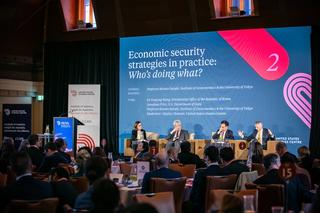
Yunjong Wang noted that the traditional economic case for industrial policy hinged around either ‘infant industry’ protection or addressing externalities. Now geopolitics is superseding economics in justifying industrial policy, but there still needs to be clear analysis of the case for subsidies. Jonathan Fritz recognised that industrial policy is not perhaps the first policy choice, nor has it always been successful. In many ways, the United States is being forced to play the game or risk letting China dictate which sectors of the future economy it will dominate. It is nonetheless vital that the United States and its allies avoid a subsidy battle by aligning and taking account of each other’s strengths and weaknesses.
Session 3 | US-China economic competition: An insider's perspective
Dr Elizabeth Economy, Hargrove Senior Fellow at Stanford University’s Hoover Institution, provided a tour d’horizon of US-China relations. The period since China’s entry into the World Trade Organization (WTO)in 2001 captures the initial promise and ultimate dashing of US hopes regarding the path China would follow. The US-China relationship today is more complex and challenging than at any time since the normalisation of relations in 1979. China has changed, though the United States also bears some responsibility for the deterioration in the relationship.
The US-China relationship today is more complex and challenging than at any time since the normalisation of relations in 1979.Elizabeth Economy
One inflection point was in 2008. China hosted the Olympics in 2008, symbolising its emergence on the global stage as a great power, as the United States succumbed to the global financial crisis. A second inflection point came in 2012 with the advent of Xi Jinping as General Secretary of the Communist Party. Under Xi, the quest for the “great rejuvenation of the Chinese nation” would see China become more repressive and authoritarian at home and more ambitious and expansive abroad.
The great rejuvenation has played out across five dimensions: efforts to redraw the map of China; an intention to push the United States out of its role as the dominant military power in the Indo-Pacific region; strategies designed to align other countries with China’s objectives (e.g. the Belt and Road Initiative); initiatives aimed at reforming global governance; and moves to 'securitise' the Chinese economy and ensure China is less reliant on others, while continuing to access global markets. All pose challenges to the United States and to other market democracies.
Support for a strategy of engagement with China has fallen markedly within the business community and civil society in the United States. The Biden administration’s approach of “managed competition” with China stresses the need to “invest, align and compete.” This includes investments in innovation and manufacturing capabilities (e.g. CHIPS and Science Act and the IRA), alignment through new arrangements with partners (e.g. IPEF, AUKUS) and competition in sectors like semiconductors and green technologies. There remain areas of cooperation, but all the signs point to a continued “bumpy road” in the US-China relationship.

Richard McGregor, Senior Fellow at the Lowy Institute, reflected on how US-China strategic competition is viewed in different parts of the Indo-Pacific region. China has been quite successful in promoting a narrative that the post-American world in Southeast Asia is a Sinocentric one. And whereas in Australia the dominant view is that China’s assertiveness is the main source of regional instability, China has been relatively effective in other places in framing instability from US-China competition as more of an American problem. The focus of China’s narrative on development (not democracy) also works well in Southeast Asia. China nonetheless faces a more contested environment on several fronts. Foreign investment in Southeast Asia is one area where the United States should do more to tell its story.
In Australia, debate over the Future Made in Australia plan highlights the deep reservations in some quarters about greater industry intervention. Other countries such as Japan have greater muscle memory in this area. In the context of Chinese competition in a sector like critical minerals, there will need to be coordinated and sustained support over decades to build alternate sources of supply.
Reflecting on her time in the US Department of Commerce, Elizabeth Economy sounded a positive note about the willingness of the US private sector to engage on the development of new economic tools, including on IPEF, semiconductor investments and export controls. By bringing people around the table, it was possible to get a more detailed understanding to support better decision-making.
Both speakers reflected on the challenges of interpreting modern China. Richard McGregor argued this is most acute at the apex of decision-making, especially when it comes to President Xi’s timeframes. There is some comfort in the reality that while Beijing may desire greater self-sufficiency, global links will remain important in areas like energy and food, thus increasing the costs of state conflict. Elizabeth Economy argued that Xi Jinping tends to follow through on what he says. There are increasing debates in Chinese academic journals on issues like support for Russia and the direction of China’s economy, but whether that has any impact on policymaking is unclear.
Keynote address | Economic policy in a changing world
Dr Steven Kennedy PSM, Secretary to the Australian Treasury, delivered a landmark address on Australian economic policy in “a more contested, more fragmented and more challenging global environment” where the goal is to protect both economic and strategic interests.
A more multipolar global order has brought with it renewed geostrategic competition and a new paradigm where “economic and financial tools are being deployed much more aggressively to promote and defend national interests.” This has profound implications for Australia in a context where the nation’s “primary economic and strategic partners are no longer the same.”
A more multipolar global order has brought with it renewed geostrategic competition and a new paradigm where “economic and financial tools are being deployed much more aggressively to promote and defend national interests.”Dr Steven Kennedy PSM
There is a need for sound, proportionate and balanced policies that enhance economic security and national resilience. Three aspects loom large in this context:
- A ‘small yard, high fence’ approach for genuinely critical infrastructure and technology;
- Delivering more resilient domestic supply chains through highly tailored responses; and
- Playing our role in strengthening global supply chains.
In each case, there is a strong case for government intervention, though this needs to be supported by clear principles and discipline around the deployment of government resources.
The Australian Government’s Future Made in Australia agenda, incorporating the new National Interest Framework (NIF) that Treasury will administer, seeks to strike the right balance in adapting and responding to new realities while avoiding over-correction and a zero-risk approach.
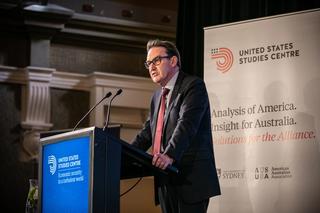
Alongside the Economic Resilience and Security Stream of the NIF, the net zero transformation stream will be used to identify domestic sectors that can make a major contribution to emissions reduction, here and globally, at an efficient cost, and in areas of long-term comparative advantage.
A strong commitment to markets, open trade and investment and effective, rules-based institutions remains vital for a mid-sized open economy like Australia. At the same time, we need to adapt to new challenges in a vastly different global environment.
Policy advisers will need to continue to “better integrate economic and strategic policy, to provide truly joined up advice to government and strike the right balance. If the right balance is struck, we can deliver both economic prosperity and secure our national interests. If the wrong balance is struck, neither will be delivered.”
Read Secretary Kennedy's full addressSession 4 | Political risk and global shocks: What keeps C-suites up at night?
An expert panel explored the interface between geopolitical risk and corporate strategy. McKinsey & Company’s Ziad Haider cited the firm’s surveys showing that CEOs rank geopolitical risk as their top risk, with political transitions or elections as the top emerging risk. There is an “asymmetry,” however, in that managing geopolitical risk ranks five or six on priorities, lower than business fundamentals like growth or technology application. For many companies, understanding the problem sits alongside not having readymade solutions because it is such an elastic and diffuse issue.
The task of building geopolitical resilience can be addressed across three domains. The first is “insight.” With diverse sources of information, companies need a baseline of facts. Some form of geopolitical risk unit that can be “an eye in the sky” to help position the organisation and interpret information is increasingly important. The second domain is “oversight” which has several dimensions including supply chains, R&D, people, capital, ownership and legal entities. The final domain is “foresight” as companies need to consider future scenarios and prepare for what is around the corner.
Sally Auld, Chief Investment Officer at JBWere, described the new conversation with investors around “regime change.” The benign investment environment of the past 20 to 30 years characterised by declining interest rates and free movement of trade, capital and labour is over. Portfolios need to be diverse, but heightened geopolitical volatility means some aspects of geographical diversification may not work as well. There are opportunities in a world of higher competition for capital and higher interest rates but seizing them requires building greater resilience into portfolios for higher levels of inflation. Geopolitics matter both for portfolio construction and for relative asset prices. All else equal, taking account of geopolitical risk means pricing in more risk premia across all asset classes.
The benign investment environment of the past 20 to 30 years characterised by declining interest rates and free movement of trade, capital and labour is over.Sally Auld
Turning to monetary policy, Sally Auld stressed the different environment facing central banks compared with a period of confidence in the supply side of the economy. Previously, the focus was on demand management and inflation targeting. If anything, the challenge was how to get inflation a little higher. Now, central bankers are having to navigate not just demand moving around but also greater supply side volatility, as illustrated by the focus on supply chains. For investors, a robust framework for asset allocation is even more important in what is likely to be an environment of shorter economic cycles, more ups and downs in interest rates and more financial market volatility.
Neville Power, Chair of Future Battery Minerals and former CEO of Fortescue Metals Group, noted that geopolitical risk is top of mind for any business with exposure to global supply chains or markets. The biggest impact is around the cost and unreliability of supply chains, which has pushed the working capital investment up in a lot of businesses. It is one of the “hidden, corrosive elements of the supply chain disruptions of recent years.” There has been an erosion of margins in many businesses due to increased costs and longer project timeframes.
For export businesses, including resources businesses in Western Australia, the geopolitical issue that looms constantly in boardroom discussions is the relationship with China. Two-thirds of the state’s exports go to China. With this high level of market concentration, the trite response is to say we need to diversify away from China. The reality is that’s not possible. The reason Australia sells so much iron ore, energy, copper and lithium to China is because that is the demand source. Nonetheless, business understands the need for balance between economic and national security interests and the need to live in those two worlds for the foreseeable future.
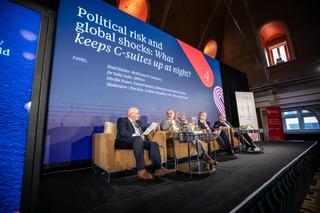
There are attempts to locate manufacturing facilities elsewhere and to domesticate supply chains into Australia, but they are at the margin. Australian experience underscores the challenges around approvals and permitting, access to capital, cost of capital and cost of construction. These are very high hurdles to bringing supply chains onshore. There are opportunities in areas like critical minerals, but we need to be clear-eyed about it. All these businesses are not going to develop downstream processing given environmental challenges and energy costs. Rather than pick companies as winners, policies should have an industry-wide focus on streamlining approvals and addressing workforce issues.
Sally Auld noted that, from a perspective of risk, investors are paying greater attention than in the past to US fiscal sustainability. The US treasury market is the most traded bond market in the world and any messy resolution to the US fiscal situation would have a major impact globally.
Ziad Haider looked beyond geopolitical risks to the “silver linings” on corporate horizons. The first is around new markets and opportunities in places like India, Southeast Asia and Mexico. The second is around key sectors such as semiconductors, energy and defence. The third is around supporting the ecosystems of new minilateral arrangements such as AUKUS and the Quad. One topic that often gets overlooked is how to talk to employees about geopolitical risk. Global organisations need to pay more attention to this issue.
Session 5 | Economic statecraft in an age of strategic competition
Tadashi Maeda, Chairman of the Japan Bank for International Cooperation (JBIC), outlined Japan’s practical approach to economic statecraft in his keynote address. This is part of a wider strategy which will see Japan increase its defence spending to two percent of GDP. Military power and economic power need to work in tandem. Japan is working closely with like-minded countries to uphold freedom of navigation and the rule of law in the Indo-Pacific. At the same time, JBIC serves as a strong instrument of economic statecraft in the area of infrastructure financing.
Military power and economic power need to work in tandem.Tadashi Maeda
Through the Asia Zero Emissions Community initiative, Japan is partnering with nine Southeast Asian countries and Australia to develop solutions to each country’s clean energy transition challenges, considering energy security and economic growth concerns. This is not a one-size-fits-all approach.
Australia and Japan are natural partners in a critical frontier area like hydrogen ammonia, as well as critical minerals. After opening a representative office in Sydney two years ago, JBIC has signed MOUs with companies such as Woodside Energy and Santos, as well as with the governments of Western Australia and the Northern Territory.
Strengthening connectivity is a second area of focus. Japan has taken a series of measures, including establishing a trilateral infrastructure partnership with Australia and the United States. This partnership has funded the undersea cable to Palau and taken steps to block Chinese control of telecommunications infrastructure in the Pacific. Japan is also partnering with the United States on the Luzon Economic Corridor in the Philippines, a multi-billion-dollar investment in infrastructure and development.
Third, Japan is strengthening regional supply chain resilience. Australia and Japan signed an agreement in 2022 on critical minerals that seeks to cover the full supply chain, including downstream processing. JBIC is encouraging the private sector in Japan to join up with partners in a range of countries in order to strengthen regional supply chains.
Across these and other areas, cooperation among like-minded countries and between the public and private sectors, is crucial. Drawing India into various partnerships, together with the United States, Japan and Australia as members of the Quad, is an important priority.Like-minded partners also need to develop flexible approaches that take account of different risk appetites so that we can tap skills and funding from different sources.
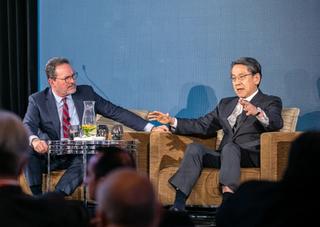
Dr Michael Green of the United States Studies Centre noted the long history of crossover between infrastructure financing and geopolitical competition. Tadashi Maeda recounted the evolution of JBIC from working under the assumption of a global level playing field to one with a more active role in geopolitical competition. This involves mitigating risks so that projects are bankable and expanding the types of credit provided beyond debt financing. JBIC has moved from a passive export credit agency to one on the cutting-edge of new financing ecosystems.
There are notable differences, for example, between JBIC and the US Development Finance Corporation. JBIC can finance projects in high-income countries like Australia and is more willing to partner with state-owned enterprises in developing countries. JBIC is also positioned to make riskier investments than the private sector.
On the scope for cooperation with China, Tadashi Maeda observed that there is still communication between JBIC and China’s state development banks. However, the landscape changed somewhat after the COVID-19 pandemic with an even greater degree of central party control over decision-making.
Session 6 | Global economic governance: Where to for the ‘rules-based order?’
In a video address, Mathias Cormann, Secretary-General of the Organisation for Economic Co-operation and Development (OECD), highlighted the growing risks of economic fragmentation from geopolitical tensions and strategic competition. These risks have been building for some time, accentuated by the COVID-19 pandemic, a major war in Europe, conflict in the Middle East, new strains of protectionism, and growing concerns about economic coercion and market concentration, especially in relation to products required for the digital and green transitions.
These forces are putting the rules-based order under significant pressure. We need to rebuild confidence in the global trading system and resist the fragmentation of the global economy into blocs. Globalisation and open markets are drivers of productivity and economic growth, while “deglobalisation, decoupling or economic fragmentation would make us all poorer.”
Globalisation and open markets are drivers of productivity and economic growth, while “deglobalisation, decoupling or economic fragmentation would make us all poorer.”Mathias Cormann
More needs to be done to ensure a level playing field for global trade. The OECD has an important role to play, providing governments with objective data and policy analysis that takes account of risks and helps to mitigate them. Helping policymakers achieve the right balance is a key priority of the OECD.
Areas of focus include:
- The development and implementation of OECD standards and best practices across a range of policy areas;
- Helping build capacity to identify and anticipate risks in critical supply chains, including with granular trade data focused on supply chain dynamics;
- Providing objective data and analysis to support trade liberalisation, improve transparency and track restrictions;
- Supporting governments to design sound industrial policies that leverage, rather than undermine, well-functioning markets;
- Helping countries implement sound foreign investment controls that address national security concerns without undermining business certainty;
- Enhancing the social and environmental sustainability of trade and investment; and
- Ensuring action on climate change remains trade-friendly and avoiding climate protectionism.
The sustainable expansion of global trade and investment remains one of the most important drivers of further economic development and growth. This is a core motivating principle of the OECD’s global engagement beyond its membership.
Professor Myung-hee Yoo of Seoul National University, the former Trade Minister of South Korea, drew attention to the shift in recent years from “rules-based to security-driven trade governance” and the impact on the rules-based order. Her role as chief negotiator on the US-Korea free trade agreement renegotiation during the Trump administration provided first-hand experience of this phenomenon.
The pursuit of economic security has become a defining feature of current economic and trade policy. While countries may have good reasons to pursue restrictive economic security measures, such policies come at a cost. Economic security cannot be used as a “blank cheque.” We must strike the right balance between restricting trade for security concerns and preserving the rules-based system.
Economic security cannot be used as a “blank cheque.” We must strike the right balance between restricting trade for security concerns and preserving the rules-based system.Myung-hee Yoo
Despite increased restrictions, 75 per cent of global trade still operates under multilateral rules. This has supported the integration of East Asia into the global economy. East Asian countries continue to support free trade, highlighted by the finalisation of the Regional Comprehensive Economic Partnership (RCEP) agreement during the COVID-19 pandemic.
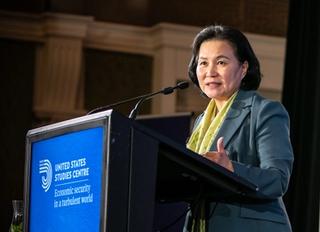
The multilateral trading system needs to adapt and evolve. This means addressing economic security concerns, while ensuring measures are proportionate, fair and transparent. An expanded trade agenda would include sectoral arrangements, industrial policy guardrails to avoid a subsidy race, coordinated action on climate and trade and the digital trade agenda. Bilateral and regional agreements – such as RCEP, IPEF and the Comprehensive and Progressive Agreement for Trans-Pacific Partnership (CPTPP) – could serve as useful forums to discuss red lines in policy, helping to limit negative spillovers from unilateral economic security actions.
In the panel discussion, George Mina, Deputy Secretary of Australia’s Department of Foreign Affairs and Trade, stressed that for a country like Australia, “economic security is found in the rules-based system.” It acts as a buffer against raw economic power and protectionism.
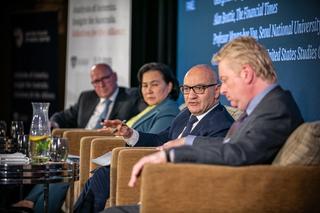
The dispute architecture and the rule-making functions are of vital importance. At the same time, the system needs to be flexible or it will get ignored. It needs to find ways of dealing with security concerns, non-market practices and climate issues. Middle powers like Australia, South Korea, Canada and the United Kingdom have agency and it is important they exercise it.
To Alan Beattie of the Financial Times, the main problem is that the WTO is ungovernable, as a large organisation with lots of disparate views that works by consensus. Coalitions of the willing are a good idea, but the rule-making side of the WTO continues to struggle. The dispute settlement system is a bright spot, despite the absence of the United States, especially where disputes are defused in the early stages.
The EU’s Carbon Border Adjustment Mechanism (CBAM) will be a critical test case on climate action and trade. India has already challenged it in the WTO and the dispute settlement system may help to refine its implementation and improve its legitimacy. The real issue in relation to China is that WTO rules don’t constrain Chinese capitalism in a way that addresses market distortions.
Panellists surveyed the prospects for trade should Donald Trump win the November 2024 election. Myung-hee Yoo highlighted the risk that the United States would again use high tariffs to target countries where the United States has a trade deficit. George Mina stressed that while there may be pressures for tit-for-tat tariff retaliation in some countries, Australia will work with other middle powers to maintain openness. Alan Beattie was pessimistic about constraints on President Trump given limited internal checks and balances.
Europe’s economic security strategy: A view from Brussels
In video remarks from Brussels, Denis Redonnet, Deputy Director-General and Chief Trade Enforcement Officer in the Directorate-General for Trade in the European Commission, provided an overview of the European Union’s economic security strategy. The challenge is one of balancing different logics in the context of a “paradigm shift” which has seen higher governance priority on security and resilience relative to the logic of efficiency. Economic integration will likely sit alongside pockets of “de-integration” amid a shift towards more power-based economic relations.
The EU’s economic security strategy is designed to work jointly between the EU institutions and the 27 member states which retain national competence in relevant security domains less traditionally integrated into the Single Market. This is a more complicated game compared with an open markets trade and investment policy.
The strategy gives definition to the notion of de-risking the economy vis-a-vis external threats or unwanted economic dependencies. The white paper released by the European Commission in mid-2023 outlines key pillars (echoing the “3 Ps” identified by Dr Wang from South Korea). The “promote” pillar aims to build the resilience and competitiveness of the EU’s industrial and technology base; the “protect” pillar aims to mitigate risks from the weaponisation of dependencies or technology leakage; and the “partner” pillar underlines the importance of maintaining connection to the global economy.
The strategy includes a series of workstreams. Joint risk assessment exercises are being conducted on key technologies – advanced semiconductors, AI, quantum and biotechnology. Further risk assessments are being conducted on industrial supply chain dependencies, risks to critical infrastructure and the risk of the weaponisation of economic dependencies. Other initiatives include a proposal to upgrade and “Europeanise” the framework for screening inward foreign direct investment for security and public order reasons. There is also work underway on possible screening of outward investment, export controls and research security.

Separate from the economic security strategy, the EU has developed new tools designed to ensure a level playing field with key trading partners and address “gaps in the global trade rulebook.” These include instruments to deal with distortions caused by foreign subsidies. Instruments must correspond to a particular problem or gap in the world trade rulebook. It is important to avoid “mission creep” and ensure the rules-based trading system remains a cornerstone of economic security.
Conference dinner panel | Fusing security and economic interests: Practitioners’ perspectives
At the conference dinner, Dr Michael Green of the USSC moderated a panel discussion with senior Australian officials charged with integrating national security and economic interests. Andrew Shearer, Director-General of National Intelligence and head of the Office of National Intelligence, observed that “the old silos have completely broken down” in this more contested, fragmented and challenging environment.
Intelligence agencies have a particular role in this new era. To adapt the ‘small yard, high fence’ metaphor, this involves aspects of being the “landscape designer” or “quantity surveyor” – advising on where the fence should go and what the contours should be – and also as the “back to base monitor” – alerting government and society when someone is planning to get over, under or through the fence.
The range of issues to be weighed in decision-making is enormous – everything from how we think about technology, to how Australia delivers net zero commitments affordably without jeopardising sovereignty and national security, to how we mitigate foreign investment risks while preserving economic benefits. Economic security, moreover, is not just a whole-of-government challenge. Issues require a whole-of-nation approach, especially when one considers that governments do not own or control key technologies and critical infrastructure assets.
Meghan Quinn PSM, Secretary of the Department of Industry, Science and Resources, outlined how national security issues touch virtually all parts of her department’s agenda – from the role of gas in the Indo-Pacific region, to nuclear waste management, to the regulation of AI. Thinking through these issues requires a multidisciplinary approach, taking account of a diversity of views. Working across national security and economic agencies, a key task is to understand the source of various shocks and the tools available to respond to them.

David Fredericks PSM, Secretary of the Department of Climate Change, Energy, the Environment and Water, described his department as an economic department charged with driving the domestic energy transition, but also a department of national security and foreign policy. Advice on domestic policy needs to reinforce Australia’s national interests and national security objectives. That is the responsibility public servants now carry.
In an area like multilateral climate change negotiations, we are seeking climate objectives but there are also geopolitics at play. Geopolitical relationships matter to our domestic policy. Australian Government investments in areas like green hydrogen, for example, are taken with a view to Australia’s benefit, but also with a view to playing our role in a way that benefits partners and allies.
Looking at relationships with industry, David Fredericks affirmed that the key priority is to create an environment conducive to business investment. Policy certainty using the best available tools is vital to the goal of crowding-in private investment. It is not the job of industry to think to itself: “how can I invest in order to maximise Australia’s national interest?” The COVID-19 experience showed that we get the best results through regular consultation between government and industry. “Public servants are now more willing to pick up the phone and talk
to business.”
Meghan Quinn noted the reality that in a market-based economy there are some risks that businesses can’t insure against – an example being a mid-sized critical minerals company up against the balance sheet and taxing powers of a large state actor like China. Governments have the capacity to step in where the risk cannot be insured by private capital. There is a need to work with business to understand why businesses are not doing certain things, and then think about appropriate tools. The tool might be direct investment, co-investment, regulation or simply better dialogue.
Andrew Shearer stressed that the goal from his perspective is to build trusted partnerships with Australian business. Prosperity and security are “two sides of the same coin.” Australia needs a strong, open economy to pay for national resilience and defence. Equally, governments cannot secure critical infrastructure or supply chains without the private sector. There needs to be a symbiotic relationship.
Panellists spoke about the avenues for engagement and coordination on economic security issues with international partners. Andrew Shearer observed that, from an intelligence agency point of view, countries are more likely to arrive at aligned policy responses if they share information. For Australia, economic security issues have become much more central to discussions within the Five Eyes, as well as with Japan, South Korea, and increasingly with partners in Southeast Asia and the Pacific.
Meghan Quinn cautioned about the risk of layering too many mechanisms on top of each other. In the area of critical minerals, for example, there has been considerable activity “analysing the problem” across many forums. The time has come to use existing mechanisms to fix the problem around critical minerals supply chains “which means money on the table” and moving to action. There is a need to move from architecture to the solutions stage. Something similar applies in areas like space cooperation and AI collaboration.
The time has come to use existing mechanisms to fix the problem around critical minerals supply chains “which means money on the table” and moving to action.Meghan Quinn
David Fredericks observed that, while there can be a strong desire for like-minded partners to come together, there are also domestic objectives that can be in tension. Elements of the IRA in the United States provide one example, given its significant implications for the rest of the world. Partner countries need to demonstrate they have the capacity to identify mutual interests and find mutually advantageous solutions.
Session 7 | Technology dynamics, disruption, and de-risking: The security-prosperity nexus
Emily Kilcrease, Senior Fellow at the Center for New American Security, examined the evolution of US technology policy and its place at the centre of economic security debates. In the early 2000s, Washington pursued a “run faster” strategy geared to US technology leadership. The idea was that US tech firms needed access to global markets, including China, to drive revenues and investment in R&D, leading in turn to further technological advancements. This approach had both a strategic and commercial logic, with the US military highly dependent on commercial capabilities to power its platforms. However, it also left the national security apparatus more dependent on commercial markets.
Defensive measures such as export controls were viewed as a policy backstop, while the policy intent was to differentiate between civilian and military users in a country like China. Trade could take place for defined commercial purposes, as long as the United States remained one to two generations ahead of China.
By the mid-2010s, the ground had shifted, and the run faster strategy had begun to fray. China was now a major technological power, frustration with Chinese economic practices had grown and its rapid military modernisation and geopolitical assertiveness posed a more profound strategic threat to the United States. A new strategy, first articulated by the Biden administration’s national security advisor Jake Sullivan in 2022, looked to ensure the United States maintained “as large of a lead as possible” over China in key technologies such as AI, semiconductors and quantum.

Rather than stay a generation or two ahead of Chinese competitors, the US goal would be to “freeze them in place,” with no differentiation between civil and military uses or users in China. The Biden administration announced a series of actions, including export controls and proposed investment restrictions on investments in China. When combined with industrial policy measures, the US strategy is to “shock the shape of critical technology supply chains” into a more desirable configuration. This new approach has its critics. Industry concerns centre on not being able to invest as much in R&D. Most US allies are reluctant to go so far in declaring entire tech ecosystems off limits to China. There are legitimate questions about the reach and effectiveness of the ‘small yard, high fence’ strategy.
US strategy is to “shock the shape of critical technology supply chains” into a more desirable configuration.Emily Kilcrease
Two changes are critical. First, Washington needs to reshape its economic security bureaucracy, bringing in a wider set of skills to ensure policy effectiveness and alignment. Second, the United States needs to match its defensive measures with an affirmative vision of US leadership in this economic security era, working with international partners like Australia to establish new norms.
Mike Yeh, Regional Vice President of Corporate External and Legal Affairs at Microsoft Asia, explored the “new latticework” of public and private sector collaboration required for an era of rapid technological advancement. Governments, defence forces, civil society and industry must come together as part of this endeavour, especially given the national security implications of technologies like AI. The contrast of today with the dawn of the internet era illustrates the changed landscape. Thirty years ago, governments and universities had the fastest connections. When you think about who has the best access to AI technologies, that is no longer the case.
Partnerships are critical. Microsoft is part of the National AI Research Resource in the United States, a government-private sector partnership designed to make the best AI resources accessible to academics and researchers. Across Asia, Microsoft is making infrastructure and skills investments in the Philippines, Malaysia and Indonesia to accelerate the use of AI. Earlier this year, Prime Minister Albanese joined Microsoft President Brad Smith to announce a A$5 billion investment in Australia to expand cloud computing, strengthen cyber security and provide AI skills. Microsoft is supporting AUKUS, another example of cooperation and collaboration. Hyper-scale cloud is a foundation for AUKUS and for the opportunities that new technologies open up for the Australian defence industrial base. Such partnerships are crucial “force-multipliers” for collective resilience.
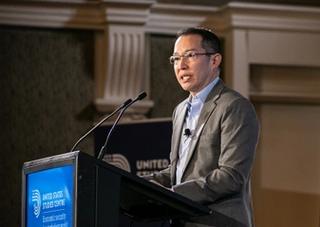
On the flipside, partnerships can be force-multipliers for adversaries. A strong latticework will be necessary to defend like-minded countries from future threats. State adversaries and non-state actors are using AI to increase their capabilities and find new ways to attack governments, businesses and individuals. This should be a wake-up call for regional governments keen to leverage AI. Many governments are far from being able to do so at this point. First steps include moving data into structured datasets and getting it onto the cloud.
A path forward is to create new mechanisms for “trusted collaboration and interoperability.” Microsoft’s partnership with the Australian Signals Directorate on the Cyber Shield is a good example of effective collaboration. Ultimately, governments need to have a “real-time dashboard of cyber-attack and threat information” across agencies, critical infrastructure and the private sector. That information should be structured in a way that it can be shared with like-minded governments in real-time. A strong latticework, underpinned by secure technology and collaboration between governments and the private sector, is essential to regional stability.
A strong latticework, underpinned by secure technology and collaboration between governments and the private sector, is essential to regional stability.Mike Yeh
Professor Kazuto Suzuki from the Institute of Geoeconomics identified four factors Japan assesses in differentiating strategic and non-strategic technologies: (i) overdependence on one country for a technology (particularly a hostile one), (ii) the technology’s national security implications, (iii) whether the technology has alternate suppliers, and (iv) the technology’s future industrial implications. In discussions with the United States over semiconductor export controls, the decisive factor in securing industry support in Japan was the national security implications. That is quite different from thinking about green technologies, for example.
Emily Kilcrease provided further clarity on why frontier AI capabilities coupled with advanced semiconductors pose such security concerns, citing the prospect of more accurate hypersonic missile or nuclear testing or the development of novel biotoxins. New US export controls remain focused on these advanced AI capabilities. Beyond such national security risks, Mike Yeh stressed that AI has further economic security ramifications through its potential to transform data-intensive industries such as pharmaceuticals and mining. Microsoft’s approach to responsible AI looks to define “sensitive use cases”: notably, physical wellbeing or medical decisions, consequential financial decisions (including in relation to job applications) and human rights implications (such as the potential for mass surveillance).
Panellists discussed how bureaucracies need to evolve to better manage risks in the evolving technology landscape. Emily Kilcrease stressed the need in a US context for better resourced analytical and evaluation capabilities to assess the effectiveness of tools such as export controls. And rather than waiting for a crisis such as Russia’s invasion of Ukraine to catalyse thinking, key economic agencies require a dedicated strategic planning function to consider scenarios. Kazuto Suzuki suggested the Japanese Government needs to broaden its approach to AI with a stronger emphasis on commercial opportunities. This would require greater policy coordination across Japanese government agencies.
In terms of risks, Mike Yeh suggested more attention needs to be given to the challenges posed by disinformation and misinformation. A key issue for government and industry is attribution. An even larger question surrounds how to educate people about these risks. Kazuto Suzuki detected some improvement in public awareness about misinformation and disinformation, highlighting in this context recent elections in Taiwan.
Amid concerns about more security-oriented digital trade governance, Mike Yeh suggested that national security concerns remain focused largely on frontier AI models. Most AI solutions are not controversial and not subject to stringent regulations. Emily Kilcrease emphasised the need to better integrate discussions on digital trade and AI governance to ensure proper government oversight without stifling innovation. Novel questions are arising beyond export controls on semiconductors, given AI also encompasses open-source models, data centres, and cloud services.
Session 8 | Indo-Pacific energy security and Australia's role in the energy transition
In video remarks from Washington DC, Dr Daniel Yergin, Vice-Chairman of S&P Global, framed the larger backdrop as one where, as distinct from the Cold War, great power competition and global integration exist at the same time. The consensus that economic integration is beneficial has eroded. Globalisation is not over, but it has fragmented. The fragmentation is clear in energy markets.
Globalisation is not over, but it has fragmented. The fragmentation is clear in energy markets.Daniel Yergin
The global energy market ended with Russia’s invasion of Ukraine. It is remarkable that prices have remained relatively stable despite conflicts in Ukraine, Gaza and the Red Sea. A key factor has been the rise of gas and oil supply from the United States which has provided a security cushion. Without US gas supply, it is doubtful that Europe could have withstood the cut off from Russian gas.
The reality is the energy transition is getting more difficult, not in terms of direction but in terms of timing. The temporary drop in energy demand during the COVID-19 pandemic led to linear thinking about the path to net zero. In reality, this will be a multidimensional energy transition which will involve different energy mixes in different parts of the world based on varied strategies and technologies.
Four reasons explain this reality. The first is the return of energy security in the wake of the Ukraine war where, notably, the US Energy Secretary has at times been urging energy producers to increase output. The second factor is the sheer scale of the transition in a (short) period of 25 years. Compounding the issue of scale are big supply chain problems for green energy technologies. Third, there is a North-South divide on energy, with different priorities and aspirations in emerging economies and different views about the role of hydrocarbons. Finally, and importantly for Australia, there is the challenge around the supply of minerals critical to net zero. Estimates are that to stay on track copper output needs to double by 2035, yet it takes 20 years to bring on a tier one mine. The degree to which China dominates supply chains for minerals processing will become an even bigger issue in the future, one where the energy transition collides with great power competition.
Paul Everingham, Chief Executive Officer of the Asia Natural Gas & Energy Association, highlighted the importance of gas to energy security in the Asia-Pacific region. Gas supply is critically important to countries like Japan, Korea, Singapore and Taiwan, and increasingly important to the likes of Vietnam, India and the Philippines. As reliance on coal and diesel power declines, demand for gas and renewables in the region will rise. Contrary to some claims, the evidence does not point to declining gas demand.
In recent times, the United States and Australia have sent mixed messages about the export of gas to the region, and this has obvious economic and geopolitical implications. The opportunity exists for the United States and Australia to be the “guarantors of energy security in the Asia-Pacific region.” Australia’s Future Gas Strategy acknowledges the need for more investment, but some Asian stakeholders remain concerned that Australia will prioritise domestic supply over exports. It should not come down to this binary equation. The key issues are political will and policy settings.
In the panel discussion, Paul Everingham expanded on the diversity of energy systems in Asia. In Northeast Asia, most countries have multiple sources of supply in modern electricity supply systems. Other countries remain heavily reliant on coal, with big decarbonisation gains possible from switching to gas. With some exceptions, most countries in Asia do not have the landmass for reliance on renewables. And in Southeast Asia, the science of the equator – little wind and significant rain – reduces the effectiveness of solar generation. Solutions must be realistic, practical and affordable. Daniel Yergin pointed to growing electricity demand in the United States from the reshoring of manufacturing, data centres and the growth of AI. How to meet this higher electricity demand is now an important topic.

Meg McDonald, Non-Resident Senior Fellow at the United States Studies Centre, noted the reckoning in prospect around climate action goals. Governments and many industry players underestimated the economic complexity of this transformation. It needs to be thought of as a whole-of-economy transformation, rather than an energy transition. Countries are experiencing significant delays in infrastructure and supply chain transformation and certain green technologies still need to reach maturity to be cost-effective.
What’s important is to have the foundations for a 2050 outcome, including the buildout required for electrification and renewables, while also reducing the carbon intensity of other fuels. More attention needs to be paid to private sector financing, particularly given the requirements in developing countries. A sleeper issue remains the social license around this transformation. There are lessons here for countries like Australia from the IRA in the United States to ensure this process is inclusive from a social point of view.
Tania Constable, Chief Executive Officer of the Minerals Council of Australia, pointed out how political parties are focused on particular technologies like gas, nuclear or renewables, rather than the overall goal. The mantra of the last couple of decades has been affordable, reliable and clean energy. By 2050, Australia will need a diverse energy system, not just one energy source or technology. From a systems-based perspective, you will get a better outcome with diverse energy sources and by spreading the risk.
There will be growing energy demand. For now, we need to replace unabated coal with gas and roll out as many renewables as possible, build out transmission and distribution where it makes sense, and explore nuclear. But Australia also needs to recognise that the rest of the region is still industrialising. Australia’s exports 90 per cent of its minerals. It needs to recognise the geopolitical and economic constraints facing our partners in the region.
On net zero by 2050, Meg McDonald argued the focus should be on policy stability and planning, not abandoning the goal. Trade-based approaches like CBAMs and the WTO could play a role in smoothing the path forward.
To tackle decarbonisation, Tania Constable observed that the world will need more metals and minerals in the next 30 years than we have used in the past 70,000 years. Our supply chains are under pressure, and we need to be able to build the required mines. Approvals are taking far too long in Australia and other policy impediments to investment also need to be addressed. In addition, Australia needs to partner with like-minded countries in our region from an economic security perspective, especially given the experience of price manipulation in key supply chains.
The world will need more metals and minerals in the next 30 years than we have used in the past 70,000 years.Tania Constable
Session 9 | Reconciling security and prosperity: What's at stake in 2024?
Jan Adams AO PSM, Secretary of Australia’s Department of Foreign Affairs and Trade, reflected on how to think about reconciling security and prosperity. While it implies a trade-off between two separate objectives, at a national level the two objectives are “co-dependent.” A country without security has no chance of being prosperous. And without economic strength, we cannot marshal the resources to provide defence and national security investments. In foreign policy, it is about optimising a set of national interest objectives.
In today’s less than benign global environment, geostrategic competition is also economic and technological competition, as illustrated by the geoeconomic consequences of Russia’s invasion of Ukraine or China’s rise up the global value chain in key sectors. The international context is “already fusing security and economic issues all the time.”
The international context is “already fusing security and economic issues all the time.”Jan Adams
The integration of policy work across the Australian Government can be seen in three examples. The first is the China relationship. As Premier Li Cheng’s visit to Australia highlighted, it is not just about the economic relationship. Australia’s interests and concerns include issues such as cyber security, critical infrastructure, global supply chains, international rules, defence actions, alignment with Russia and more.
A second example is Southeast Asia. Where the objective is a strategic balance in our region, Australia must play its part as a partner for economic development. The Australian Government’s Southeast Asia economic strategy sees cooperation across many Australian departments and agencies, working with business. The third example is the Pacific where Australian engagement and whole-of-government efforts span the entire economic development, aid, social policy, security and climate change spectrum. The Falepili Union with Tuvalu, including the human mobility pathway, is a singular example of this approach.
Of course, energy security is also national security and Australia’s role in providing reliable energy to Asian partners (including Taiwan) is a major contribution to regional economic security. Australia also has a deep interest in rules-based approaches in multilateral and mini-lateral institutions.
In the panel discussion, Yasuo Takamura, Cabinet Councillor in Japan’s National Security Secretariat, noted how the more complex geopolitical environment led Japan to expand the scope of national security to encompass economic and technological areas. In October 2021, Prime Minister Kishida set economic security as one of his top priorities. This was the foundation for a more integrated and holistic approach in the form of ESPA.
There are lessons to be learned from this experience but also challenges still to be overcome. On critical minerals, for example, there are programs focused on supply side issues, but demand side policy also needs greater focus and collaboration across partner countries. On advanced technologies, more needs to be done to unlock private capital because government funding programs are limited. That’s why Japan is very supportive of initiatives like the Quad Investor Network designed to increase investment across the four Quad partner countries. Another example is cooperation in the US-Japan-Korea trilateral dialogue where there is a push for greater coordination across national laboratories and researchers in the three countries.
Drawing a contrast with Japan, Senator Dave Sharma observed that Australia does not have a strong tradition of doing big, overarching statements or strategies. For a period, Australia experimented with a national security adviser, but that exercise withered on the vine. Apart from periodic defence and foreign policy white papers, Australia tends to set policy more through the accumulation of decisions rather than via some form of grand strategy. In the context of discussions on economic security, sovereign capability and technology de-risking, there is a case for some sort of overarching statement and more guidance on government thinking, particularly for the private sector.
Looking at China’s near-term outlook, Dr Elizabeth Economy from the Hoover Institution drew attention to what could emerge from the Third Plenum. In the past, Chinese leaders have used this forum to make big announcements. While there are contending views within the Chinese system, President Xi can be expected to double down on technology self-sufficiency and continue to emphasise what he calls the “new productive forces” – industrial priorities such as electric vehicles, energy storage batteries, as well as integrating AI throughout the economy.
There continue to be major economic challenges given the slump in the real estate market, problems with consumer demand, and the sharp decline in foreign direct investment in China. There is little evidence of renewed interest from foreign multinationalsdespite Chinese officials committing to improve the investment environment in August 2023. President Xi’s focus remains on control and buttressing the security apparatus. There is debate among liberal reform economists, but their capacity to influence the direction of policy appears limited. President Xi “has his own vision for how he wants to move forward.”
Jan Adams returned to the theme of government approaches to economic security. It is important to understand where systems start from and what is embedded. Some of the steps taken by Japan have been embedded in Australian Government frameworks for some time. Examples include bringing trusted business partners into discussions via security clearance systems, a formal cyber security strategy and critical infrastructure legislation.
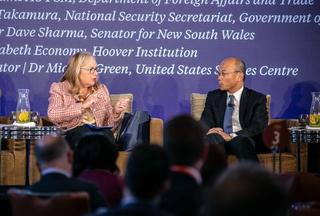
The size of Canberra makes it relatively easy to coordinate and it is an organic, daily process. National security agencies are involved in economic issues, and vice versa such that “nobody does single issue work anymore.” On economic security, Australia will continue to support rules-oriented approaches to issues. A purely power-based approach is not in Australia’s interests and “the national interest doesn’t change.” Moreover, the bulk of Australia’s economic activity still occurs in accordance with WTO rules and its network of free trade agreements.
Yasuo Takamura affirmed that Japan had learned much from the practice of Australia in an areas like security clearances and protection of critical infrastructure. This shows the capacity for like-minded countries to enhance policies through a process of mutual learning. Japan also has a deep interest in maintaining the rules-based order and that is another area for collaboration with Australia.
Turning to the 2024 US election, Senator Dave Sharma noted a tendency among some commentators to catastrophise the possible outcomes. In the case of Australia, it is sensible to proceed on the basis that we will continue to have a functional, mutual interest-based relationship with whomever is in power in Washington. The focus should be on what different partners bring to the relationship with the United States and the important issues that need to be addressed. This is not based on emotional appeals.
In the media
Treasury secretary Steven Kennedy backs strong guardrails for Made in Australia plan
The Australian
Chris Bowen’s department talks up its influence over foreign policy
The Australian
Public service chiefs reveal how national security has been redefined
The Australian
National security: will we be safe, or sorry?
The Australian
China’s ‘predatory’ tactics justify critical mineral subsidies: Kennedy
The Australian Financial Review
Why our spooks and economists are teaming up to manage China
The Australian Financial Review
Appendix A | Audience polling: Ranking risks in a turbulent world
The United States Studies Centre conducted two rounds of audience polling as part of the conference format. This exercise was designed to gauge audience views on relative threats to economic security, regionally and for Australia, as well as on priority areas for cooperation among like-minded countries in the Indo-Pacific region in the face of geopolitical tensions and economic security challenges.
Three questions were posed, and audience members asked to rank across five alternative responses from 1 (highest) to 5 (lowest). To assess whether views shifted over the course of the conference, the same questions were asked on day 1 and day 2.
The polling was facilitated by Jared Mondschein, USSC Director of Research, with support from Paul Weeks, USSC Marketing and Design Coordinator.
The three questions were as follows:
- Question 1: With 1 being the highest, rank the following threats to economic security in the Indo-Pacific within the next five years.
- Question 2: With 1 being the highest, rank the following threat to Australia’s economic security within the next five years.
- Question 3: With 1 being the highest, rank priorities for cooperation by like-minded countries in the Indo-Pacific in the face of geopolitical tensions and economic security challenges.
Figure 1 | Question 1
Figure 1 shows rankings of economic security threats for the Indo-Pacific region (question 1). State conflict ranked highest on both days, increasing its salience on day 2. The next two threats – Hackers taking down infrastructure and Economic slowdown – ranked closely together in relative terms. Both scored higher salience on day 2 with Economic slowdown moving marginally above Hackers taking down infrastructure. Non-traditional security threats slightly exceeded Paralysis and dysfunction as fourth and fifth ranked threats respectively on day 1, but with Paralysis and dysfunction ranking higher on day 2. Both saw their relative salience drop between day 1 and day 2.
Figure 2 | Question 2
Figure 2 shows rankings of economic security threats to Australia (question 2). The results were remarkably stable across both days with an unchanged rank ordering from highest to lowest of: Economic slowdown, Hackers taking down infrastructure, State conflict, Paralysis and dysfunction and Non-traditional threats. There was some increase in the salience of Paralysis and dysfunction relative to Non-traditional threats between day one and day 2.
Figure 3 | Question 3
Figure 3 shows rankings on priorities for cooperation by like-minded countries in the Indo-Pacific region. Supply chain diversification ranked highest by a clear margin across both days, increasing its salience slightly on day 2. Critical infrastructure protection and Preserving technological advantage ranked second and third on day 1, though their ordering was reversed on day 2, with the latter scoring notably higher salience on the second day. Rules and Climate Change ranked fourth and fifth across both days, with somewhat lower overall salience for Rules on day 2.
Key takeaways
- State-based national security threats loom larger for the Indo-Pacific region as a whole compared with Australia where structural or cyclical economic factors are seen as the main threat to economic security.
- Cyber security and threats to critical infrastructure – whether from state or non-state actors – rank consistently near the top of economic security concerns, both in Australia and in the region.
- Internal threats such as paralysis and dysfunction and global threats such as climate change rank lower in terms of relative economic security risks, at least in the next five years.
- The focus of cooperation among like-minded partners given geopolitical tensions and economic security challenges should be on supply chain resilience and diversification, critical infrastructure protection and preserving technological advantage.
- The search for economic security in a turbulent world will require new tools of economic statecraft to meet these challenges.





